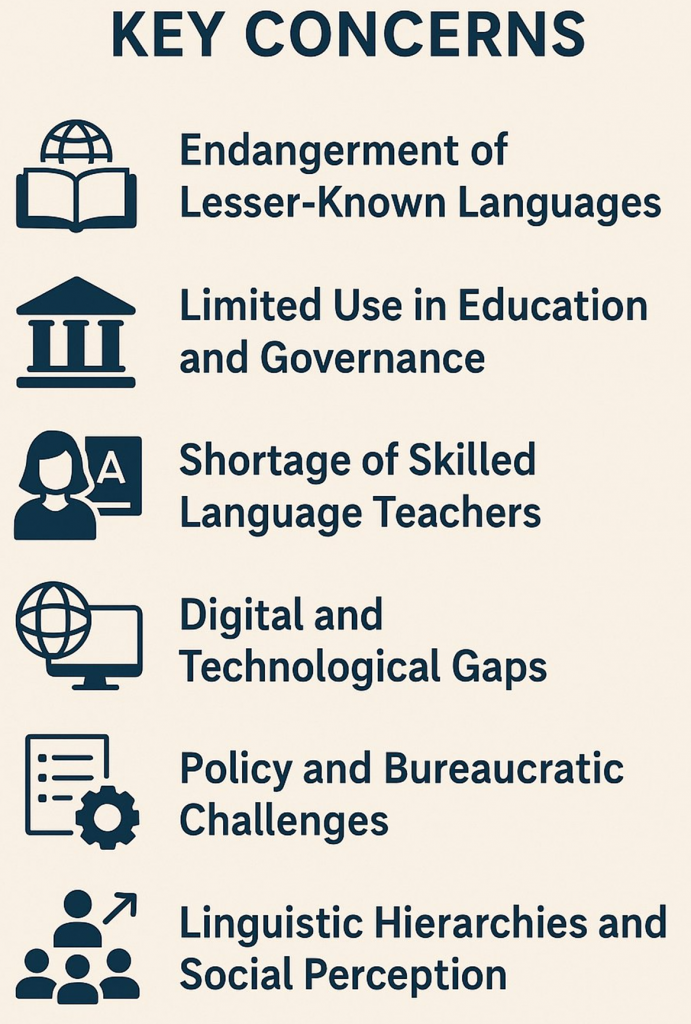Syllabus: GS1/Culture
Context
- The Department of Official Language recently celebrated its golden jubilee, marking 50 years since its establishment in 1975.
- On this occasion, the Union Home Minister underscored the importance of Indian languages in preserving the nation’s cultural identity, asserting that language is not merely a tool of communication but the ‘soul of a nation’.
About Indian Languages
- India’s linguistic diversity is not just a cultural asset — it is a foundational pillar of its national identity, democratic ethos, and inclusive development.
- Cultural and Civilizational Heritage: Census 2011 recognised 121 languages and over 1,600 mother tongues are used throughout India.
- The Indus Valley script, Brāhmī, and Kharosthī are among the earliest writing systems, reflecting India’s long-standing literary traditions.
- India has eleven recognized classical languages, i.e. Tamil, Sanskrit, Telugu, Kannada, Malayalam, Odia and recently added Marathi, Pali, Prakrit, Assamese, and Bengali.
- Constitutional and Legal Recognition: The Constitution of India recognizes 22 scheduled languages under the Eighth Schedule, affirming the equal status and promotion of regional languages.
- Article 350A mandates that states provide primary education in the mother tongue for children from linguistic minority groups.
- The Constitution guarantees the right to conserve one’s language and culture as a Fundamental Right.
- Article 343 designates Hindi in Devanagari script as the official language of the Union, while allowing the continued use of English.
- Article 344 provides for the constitution of a Commission and a Committee on Official Language to review and recommend on the progressive use of the Hindi language for official purposes.
- Article 345 grants State Legislatures the authority to adopt any one or more languages used in the State or Hindi as the official language(s) of that particular State.

Importance of Language & Policy Support
- Multilingualism as a Way of Life: Most Indians grow up speaking two or more languages.
- Multilingualism fosters intercultural understanding, social cohesion, and cognitive development, especially among children.
- Education and Empowerment: The National Education Policy (NEP) 2020 promotes mother tongue-based education up to Grade 5 and preferably till Grade 8, wherever possible.
- Competitive exams like JEE, NEET, and CUET are now offered in 13 Indian languages, expanding access to higher education.
- Digital platforms like DIKSHA and SWAYAM provide e-learning content in over 130 Indian languages, bridging the digital divide.
- DIKSHA hosts textbooks and learning resources in 33 Indian languages and Indian Sign Language.
- SWAYAM offers translated engineering content in 11 Indian languages.
- Digital Inclusion and Innovation: Under the Digital India initiative, mobile phones sold in India since 2017 must support all Indian languages, enabling broader access to e-governance and e-commerce.
- Projects like Bhashini aim to develop AI tools for Indian languages, ensuring that technology serves all linguistic communities.
- Safeguarding Endangered Languages: India has lost 50 languages in the past five decades, and many tribal and minority languages remain at risk.
- Dedicated Institutions for Language Promotion:
- Central Institute of Indian Languages (CIIL), Mysuru;
- Central Hindi Directorate, Kendriya Hindi Sansthan, and CSTT;
- National Councils for Promotion of Urdu and Sindhi Languages;
- Central Sanskrit Universities;
- Central Institute of Classical Tamil (CICT), Chennai
- Initiatives like the Bharatiya Bhasha Anubhag and the Ek Bharat Shreshtha Bharat campaign aim to foster linguistic appreciation and unity among youth.
- Dedicated Institutions for Language Promotion:
Previous article
News In Short-26-06-2025
Next article
The United Nations at 80